
What does plowing a field have to do with knitting, one may ask. The answer: As knitters know, when knitting an intarsia pattern one reads the pattern from right to left, and in the following row from left to right. This type of writing/notation is known as boustrophedon.
The word originates from the Greek: as the ox plows, down one row in a field and up the next. If you have ever mowed a lawn, unless you went freestyle, you would follow a boustrophedonic method of getting it done. I have both mowed lawns and knitted pictures or patterns in this way. Although we normally read from left to right, knitters don’t think twice about “reading” a pattern the other way as well.
Some of the earliest knitted patterned objects date back to ancient Egypt. Not incidentally, hieroglyphs can be read in both directions. This is an example of a Coptic sock. It’s amazing what people can create with a pair of sticks and some cotton yarn.
So, is knitting a brain puzzle? I say it is. A puzzle, a math problem, and a test of your patience. It has the effect of engaging both brain and hands and in the end someone gets a pair of socks or a sweater or a nice scarf. With a piece of graph paper and some creative thought, you can make up a pattern to knit, as I did here.
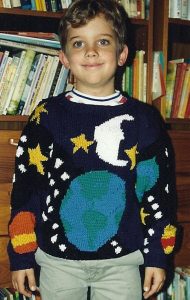 Not to brag, but I did create the universe for this ungrateful child who only wore the sweater once because he thought it was “itchy.” I am happy to report that one of my grandsons is delighted to be wearing it now. Since you start knitting from the bottom and work your way up, I began Earth at Tiera del Fuego and went north from there. This pattern is not to scale. Obviously.
Not to brag, but I did create the universe for this ungrateful child who only wore the sweater once because he thought it was “itchy.” I am happy to report that one of my grandsons is delighted to be wearing it now. Since you start knitting from the bottom and work your way up, I began Earth at Tiera del Fuego and went north from there. This pattern is not to scale. Obviously.
If I’m not knitting, I like to do word puzzles. My daily pandemic SIP routine now includes the daily Jumble and a crossword puzzle (the easy kind). I’m also currently playing online Letterpress with my son. It’s a make-words-from-letters game, more cutthroat than Scrabble. I taught my kids how to play Scrabble and Boggle, but now I’m too much of a pushover for them to play with me. Plus, they have young kids and no time for board games at a distance. My older son is a puzzle fanatic and turned me on to a BBC Two quiz show called “Only Connect.” It will blow your mind.
But back to knitting. For me, it’s a craft and a challenge: I look at it both ways.
One more example:
This was a difficult pattern to keep track of. Thank goodness it was only a small baby blanket. It reminded me of seashells and waves and once I got the hang of the complicated pattern, I loved the way it turned out. But paying attention to the stitch count was essential with this one.
One for the little granddaughter because I loved the hearts and flowers. They don’t always come out perfect, but I have learned that I’m only a perfectionist up to a point.
When the sheltering in place began, I started a blanket for myself–just a small blanket to throw over my legs as I sat on the couch binge-watching whatever. I figured that the blanket, knitted in a circle with a squared-off border, was a big enough project to last me through what I thought would be a rather short period of being confined to the house. I greatly underestimated how long SIP would last. I could’ve made a much bigger blanket had I known I’d still be hanging around here for six months and counting. (Another neat trick of knitting: by dividing the stitches between three or four needles, forming a square or a triangle, one can actually knit a circle, which is how I made my blanket.)
Confusing? Maybe just a little.
So for me, knitting is a puzzle, a math problem, a challenge, and the occasional geometric anomaly. Which is what makes it a good brain exercise.


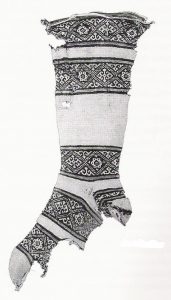
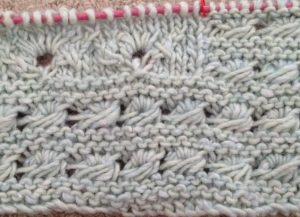
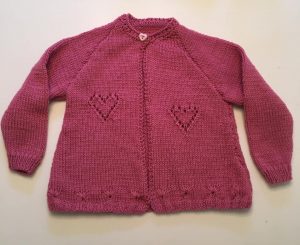
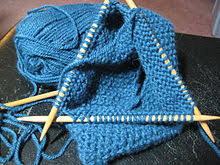
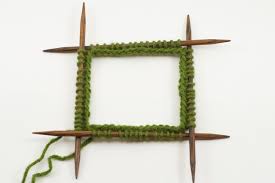

Wow Risa, a non-knitter myself I’ve never thought about knitting as brain work! And thanx for the new vocabulary word, BOUSTROPHEDONIC!
Brava to you, and what beauty you craft!
Dana, thank you so much! I love this word too, and it was fun to be able to use it in a sentence or two.
Fabulous, Risa! Both your skill at knitting (I had a talented aunt who made me gorgeous sweaters, mittens and a poncho, but never anything as complicated as the sweater you’ve shown us above) and word choices. I was taught to knit and purl as a child, but never got beyond the scarf phase. Your mathematical description is amazing (I do remember my aunt had a little counting device at the end of her needles to help her with her patterns). And the work you do certainly counts as exercise for your brain. And artistic too!
Thanks, Betsy.I’d be lost without my stitch counters! Lucky you for having such a talented aunt. It was fun to write about knitting from a new angle.
Risa, knitting is indeed a brain puzzle, and I so admire your work and that of anyone who can do it. I’m spatially challenged and tried to learn to knit when I was about 10 and failed miserably. Yet, I could do needlepoint, which is somewhat creative (I didn’t use pattern but had that canvas grid) but really isn’t a puzzle. Good for you!
Thanks, Marian. A friend taught me how to knit when we were in high school.I made plenty of mistakes, so I’m sympathetic.
Risa, I love this story so much! I learned a new word, which is great for my brain, and I got to see and hear about some of your amazing knitting creations. That universe sweater! That baby blanket! Wow! I attempted to knit a pussy hat a few years ago, and it was just too hard for me, I kept dropping stitches. Finally a kind friend finished it for me, so I could wear it to all the marches.
Thanks, Suzy! It’s fun to write about knitting in a new way. Glad you enjoyed it!
Definitely a brain game, Risa…and what a great take on it! I love that you’re “only a perfectionist up to a point.” You may already know this, but a lot of people, myself included, consider a small mistake a cherished sign of the maker’s hand in a handcrafted item. Some people actually build them in to support their belief that only G*d makes things perfectly, or so that their spirit won’t be “trapped.” I had some tile work done in my kitchen and one tile, in an inconspicuous spot, was at a slight angle, and the tile guy, a very nice person, was more than happy to redo it even though it was set in place, but I asked him to leave it the way it is. Every time I notice it, I smile.
Barbara, when we were in Spain and Portugal in the Before Times last fall, we visited a beautiful building constructed in the Moorish style. The guide pointed out that two of the doorways didn’t line up exactly. Apparently,this was done intentionally because “Only Allah is perfect.” I’ve adopted this philosophy to cover my accidental/intentional mistakes. Makes a huge difference! I agree about the cherished sign of the maker’s hand. Glad your slightly slanted tile makes you smile!
“There is a crack in everything,
That’s how the light gets in.“
– Leonard Cohen
I really enjoyed this story, Risa. Knitting is indeed a brain exercise. As a former knitter, I gave it up when I had too many kids and too little time. Made my husband a beautiful Irish fisherman sweater that he declared too itchy and warm. Wish I had kept it. Now that I have time, my hands are too arthritic. Perhaps if I had kept it up, they would be more nimble. I loved seeing examples of your beautiful creations.
Thanks for your comments, Laurie.Always nice to hear from a fellow knitter (emeritus). The tragedy of a sweater rejected…I feel for you there. My fisherman sweater, worked on during
many naps when I only had one child, was my pride and joy. I have pictures, but all my knitting projects from before 10/91. I’m sorry arthritis has forced you to put the needles down.